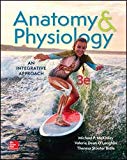
Loose Leaf For Anatomy & Physiology: An Integrative Approach
3rd Edition
ISBN: 9781260162493
Author: McKinley Dr., Michael; O'Loughlin, Valerie; Bidle, Theresa
Publisher: McGraw-Hill Education
expand_more
expand_more
format_list_bulleted
Concept explainers
Question
Chapter 16.3, Problem 10WDL
Summary Introduction
To explain:
The five basic sensations of taste and the specific stimulus recognized by each.
Concept introduction:
Gustation is the sense of taste, when the tongue comes in contact with various chemicals, it produces some stimuli. These chemicals are the stimulus to the taste buds to produce sensation.
Expert Solution & Answer
Want to see the full answer?
Check out a sample textbook solution
Students have asked these similar questions
What are the five basic taste sensations, and what is the specific stimulus detected by each?
What types of chemicals produce each of the five taste sensations?
Which cranial nerves carry taste sensation to the CNS?
Chapter 16 Solutions
Loose Leaf For Anatomy & Physiology: An Integrative Approach
Ch. 16.1 - LEARNING OBJECTIVE
1. Describe the general...Ch. 16.1 - How does a sensory receptor function as a...Ch. 16.1 - Prob. 2LOCh. 16.1 - Prob. 2WDLCh. 16.1 - Prob. 3LOCh. 16.1 - Prob. 4LOCh. 16.1 - Prob. 3WDLCh. 16.1 - Prob. 5LOCh. 16.1 - LEARNING OBJECTIVE
6. Classify the various types...Ch. 16.1 - Prob. 4WDL
Ch. 16.2 - Prob. 7LOCh. 16.2 - What are the three types of unencapsulated tactile...Ch. 16.2 - Prob. 8LOCh. 16.2 - Prob. 6WDLCh. 16.3 - Prob. 9LOCh. 16.3 - Prob. 10LOCh. 16.3 - What is the role of the mucus in detection of...Ch. 16.3 - Prob. 8WDLCh. 16.3 - Prob. 11LOCh. 16.3 - Prob. 12LOCh. 16.3 - Prob. 13LOCh. 16.3 - Prob. 1WDTCh. 16.3 - Prob. 9WDLCh. 16.3 - Prob. 10WDLCh. 16.4 - LEARNING OBJECTIVE
14. Describe the accessory...Ch. 16.4 - Prob. 11WDLCh. 16.4 - Prob. 12WDLCh. 16.4 - Prob. 15LOCh. 16.4 - What are the three eye tunics; what is the primary...Ch. 16.4 - Compare the anatomic structure of the cornea and...Ch. 16.4 - What are the functions of the vitreous humor and...Ch. 16.4 - Prob. 16LOCh. 16.4 - Prob. 17LOCh. 16.4 - Prob. 16WDLCh. 16.4 - Prob. 18LOCh. 16.4 - Prob. 19LOCh. 16.4 - LEARNING OBJECTIVE
20. Explain the bleaching...Ch. 16.4 - What are the differences between rods and cones...Ch. 16.4 - How does dark adaptation differ from light...Ch. 16.4 - What occurs during phototransduction of light?Ch. 16.4 - Prob. 21LOCh. 16.4 - Prob. 22LOCh. 16.4 - Prob. 2WDTCh. 16.4 - Prob. 20WDLCh. 16.4 - Prob. 21WDLCh. 16.5 - Prob. 23LOCh. 16.5 - Prob. 24LOCh. 16.5 - Prob. 25LOCh. 16.5 - Prob. 3WDTCh. 16.5 - Prob. 22WDLCh. 16.5 - Prob. 23WDLCh. 16.5 - Prob. 24WDLCh. 16.5 - Prob. 26LOCh. 16.5 - Prob. 27LOCh. 16.5 - Prob. 28LOCh. 16.5 - What are the steps for detecting sounds?Ch. 16.5 - Compare the difference in how we perceive pitch...Ch. 16.5 - Prob. 29LOCh. 16.5 - Prob. 27WDLCh. 16.5 - Prob. 30LOCh. 16.5 - Prob. 31LOCh. 16.5 - Prob. 32LOCh. 16.5 - Prob. 28WDLCh. 16.5 - Prob. 29WDLCh. 16 - Prob. 1DYBCh. 16 - Prob. 2DYBCh. 16 - Prob. 3DYBCh. 16 - Prob. 4DYBCh. 16 - Prob. 5DYBCh. 16 - Prob. 6DYBCh. 16 - _____ 7. Which ear structure is correctly matched...Ch. 16 - Prob. 8DYBCh. 16 - Prob. 9DYBCh. 16 - Prob. 10DYBCh. 16 - Prob. 11DYBCh. 16 - Prob. 12DYBCh. 16 - Prob. 13DYBCh. 16 - Prob. 14DYBCh. 16 - Prob. 15DYBCh. 16 - Prob. 16DYBCh. 16 - Prob. 17DYBCh. 16 - Prob. 18DYBCh. 16 - Describe the pathway by which sound waves enter...Ch. 16 - Explain how the vestibule and semicircular canals...Ch. 16 - Prob. 1CALCh. 16 - Prob. 2CALCh. 16 - Prob. 3CALCh. 16 - Prob. 4CALCh. 16 - Prob. 5CALCh. 16 - Prob. 1CSLCh. 16 - Prob. 2CSLCh. 16 - Prob. 3CSL
Knowledge Booster
Learn more about
Need a deep-dive on the concept behind this application? Look no further. Learn more about this topic, biology and related others by exploring similar questions and additional content below.Similar questions
- What are the five primary tastes? Describe how each typeof tastant causes depolarization of a taste cell.arrow_forwardWhich part of the brain is responsible for identifying a particular taste?arrow_forwardIn the brain, taste information is not transmitted through the (a) insula lobe, (b) solitary nucleus, (c) superior colliculus, (d) thalamus.arrow_forward
arrow_back_ios
SEE MORE QUESTIONS
arrow_forward_ios
Recommended textbooks for you
 Human Biology (MindTap Course List)BiologyISBN:9781305112100Author:Cecie Starr, Beverly McMillanPublisher:Cengage Learning
Human Biology (MindTap Course List)BiologyISBN:9781305112100Author:Cecie Starr, Beverly McMillanPublisher:Cengage Learning

Human Biology (MindTap Course List)
Biology
ISBN:9781305112100
Author:Cecie Starr, Beverly McMillan
Publisher:Cengage Learning
The Sensorimotor System and Human Reflexes; Author: Professor Dave Explains;https://www.youtube.com/watch?v=M0PEXquyhA4;License: Standard youtube license